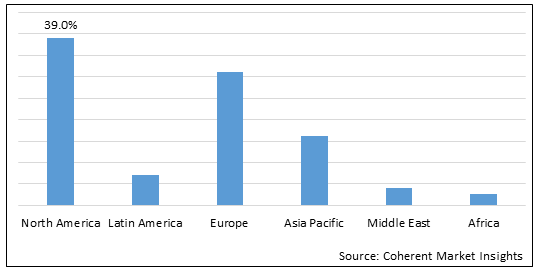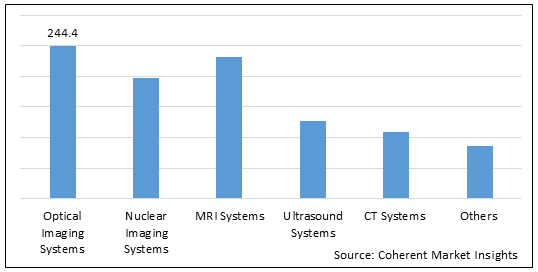Technologies in the global small animal imaging market include magnetic resonance imaging (MRI), computed tomography (CT), optical imaging, ultrasound, nuclear imaging systems, photoacoustic imaging systems and magnetic particle imaging (MPI) systems. Nuclear imaging systems include Micro-PET (Positron emission tomography) systems, Micro-SPECT (Single-photon emission computed tomography) systems, and Trimodality (SPECT/PET/Computed Tomography) systems. Optical imaging systems include bioluminescence/fluorescence imaging systems, standalone fluorescence imaging systems, and X-ray/optical imaging systems. With technological developments, scientists have successfully modified these devices to deliver enhanced imaging quality, providing scientists with better insights to research programs. Multimodal imaging devices, combination of PET, SPECT, MRI, and CT technologies, have contributed significantly in preclinical research. Research and development activities in drug development for chronic diseases such as cancer, arthritis, and others is expected to drive the demand for technologically advanced small animal imaging systems.
Global small animal imaging market is estimated to be valued at US$ 977.7 million in 2022 and is expected to exhibit a CAGR of 7.1% over the forecast period (2022-2030).
Figure 1. Global Small Animal Imaging Market Share (%), By Region, 2022

To learn more about this report, Download Free Sample
Rising cases of chronic diseases such as cancer, diabetes, cardiovascular disease, and others creates a demand for personalized medicine which can be achieved using small animal imaging. This is expected to drive growth of the global small animal imaging market over the forecast period.
For instance, according to data published in the International Diabetes Federation (IDF) Diabetes Atlas Tenth edition 2021, in December 2021, it is estimated that around 537 million adults (20-79 years) were suffering from diabetes across the globe in 2021. The same source also estimates that the total number of people suffering from diabetes will rise to around 643 million by 2030 and 783 million by 2045, globally.
Small Animal Imaging Market Report Coverage
| Report Coverage | Details | ||
|---|---|---|---|
| Base Year: | 2021 | Market Size in 2022: | US$ 977.7 Mn |
| Historical Data for: | 2017 to 2020 | Forecast Period: | 2022 to 2030 |
| Forecast Period 2022 to 2030 CAGR: | 7.1 % | 2030 Value Projection: | US$ 1,692.5 Mn |
| Geographies covered: |
|
||
| Segments covered: |
|
||
| Companies covered: |
Bruker, Aspect Imaging Ltd, TriFoil Imaging, LI-COR, Inc., FUJIFILM Holdings Corporation, Promega Corporation, Siemens Healthineers, Hallmarq Veterinary Imaging, Analytik Jena GmbH, Mediso Ltd., iThera Medical GmbH, MILabs B.V., Heska Corporation, Miltenyi Biotech GmbH, and PerkinElmer, Inc. |
||
| Growth Drivers: |
|
||
| Restraints & Challenges: |
|
||
Uncover macros and micros vetted on 75+ parameters: Get instant access to report
Figure 2. Global Small Animal Imaging Market Value (US$ Mn), By Product Type, 2022

To learn more about this report, Download Free Sample
Increasing R&D in the field of drug development and disease detection using small animal imaging systems is expected to drive market growth over the forecast period.
Small animal imaging requires animals to be injected with a radioactive biomolecule, targeting a key biomarker which controls the disease progression in case of cancer, sickle cell disease (SCD), and others. MRI, X-ray, and other imaging devices are used in development and characterization of imaging biomarkers which help to assess drug resistance and response.
Rapid research in the field of biomarkers and small animal imaging is expected to drive the growth of global small animal imaging market. For instance, according to an article published by the Blood Advances journal in September 2020, very late antigen-4 (VLA-4) has been identified as a non-invasive positron emission tomography (PET) imaging biomarker used to detect vaso-occlusive crises in case of sickle cell disease (SCD) in the U.S.
Global Small Animal Imaging Market – Impact of Coronavirus (Covid-19) Pandemic
SARS-CoV-2 (Severe acute respiratory syndrome coronavirus) was first reported from Wuhan, China in December 2019, and was declared as a global pandemic by the World Health Organization (WHO), which designates this SARS-CoV-2 infection as novel Coronavirus (COVID-19). According to the Coronavirus (COVID-19), Weekly Epidemiological Update by the World Health Organization, COVID-19 has spread across the globe infecting over 541 million population leading to more than 6.3 million deaths as of June 26, 2022. The negative impact of COVID-19 on the healthcare domain is huge and it has significantly disrupted the healthcare industries’ entire supply chain, from raw materials to manufacturing and delivery. However, the COVID-19 pandemic had a positive impact on the overall growth of the small animal imaging market, owing to use of small animal imaging systems to develop new tools, vaccines, and treatments for COVID-19 patients. The supply and production of imaging products also increased due to the necessity for research and development activities during the COVID-19 pandemic.
For instance, according to a report published by the Francis Crick Institute in the U.K., in July 2020, animal research and development activities are expected to increase during the COVID-19 pandemic. The pandemic has brought attention to the necessity of animal research in the development of safe and effective vaccines. The developments has also paved the way for new ways of working, such as a greater emphasis on bioinformatics and enhanced data sharing.
Global Small Animal Imaging Market - Restraints
High device development cost for small animal imaging equipment and stringent regulatory scenario pertaining to the small animal imaging market are the factors that are expected to hinder growth of the global small animal imaging market over the forecast period.
Clinical viability of molecular imaging devices require regulatory approval for imaging probes by the U.S. FDA and reimbursement from insurance carriers and the Centers for Medicare and Medicaid Services (CMS). This makes the overall approval process long, complicated, and expensive, as the molecular imaging devices have a large number of probes and technologies associated, all seeking prerequisite approval and reimbursement before actual launch. Hence, these regulations and approval requirements makes the market highly cost intensive, restricting the entry of new players, as well as the sales of the imaging devices.
Key Players
Major players operating in the global small animal imaging market include Bruker, Aspect Imaging Ltd, TriFoil Imaging, LI-COR, Inc., FUJIFILM Holdings Corporation, Promega Corporation, Siemens Healthineers, Hallmarq Veterinary Imaging, Analytik Jena GmbH, Mediso Ltd., iThera Medical GmbH, MILabs B.V., Heska Corporation, Miltenyi Biotech GmbH, and PerkinElmer, Inc.
Share
Share
Missing comfort of reading report in your local language? Find your preferred language :
Transform your Strategy with Exclusive Trending Reports :
Frequently Asked Questions
Select a License Type
Joining thousands of companies around the world committed to making the Excellent Business Solutions.
View All Our Clients